Comprehensive Analysis of Financial Reporting and Asset Valuation
VerifiedAdded on 2021/05/31
|9
|2775
|185
Report
AI Summary
This report provides a detailed analysis of financial reporting, focusing on the qualitative characteristics of financial statements, the impact of IFRS and GAAPs, and the implications of asset revaluation. It begins by examining the key qualities of financial statements, including understandability, relevance, reliability, and comparability, and discusses how current IFRS reporting practices may not fully satisfy these characteristics. The report then explores different theories related to government regulation, such as the public interest theory, capture theory, and economic interest theory, in the context of financial regulation. Furthermore, the report delves into the complexities of asset revaluation, comparing IFRS and GAAPs standards and discussing the reasons behind revaluation decisions, including political and debt contracting costs. It also considers the impact of revaluation decisions on shareholder wealth and the importance of fair presentation in financial statements, highlighting the challenges and uncertainties associated with asset valuation. The report emphasizes the need for accurate and transparent financial reporting to provide a true and fair view of a company's financial position.
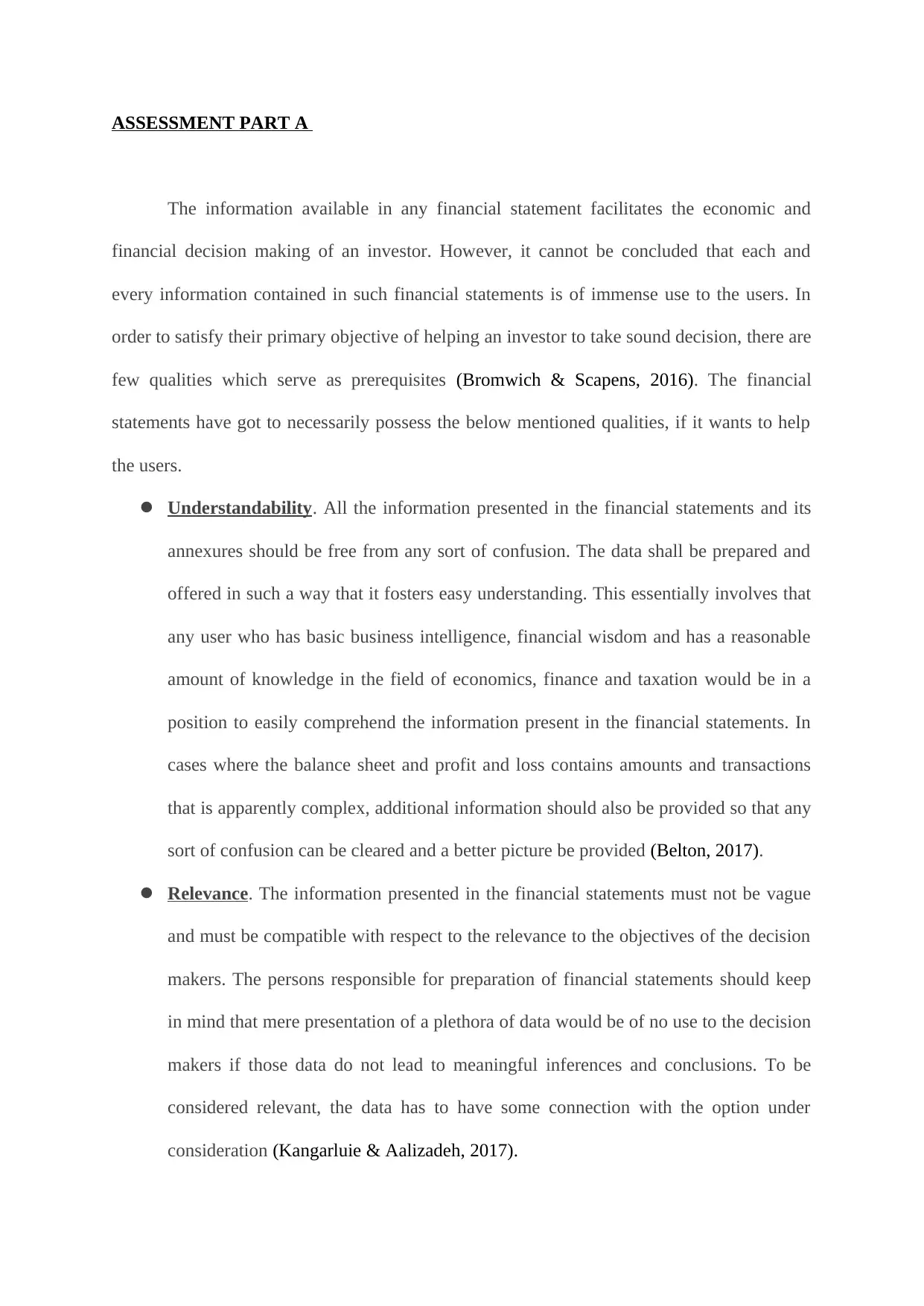
ASSESSMENT PART A
The information available in any financial statement facilitates the economic and
financial decision making of an investor. However, it cannot be concluded that each and
every information contained in such financial statements is of immense use to the users. In
order to satisfy their primary objective of helping an investor to take sound decision, there are
few qualities which serve as prerequisites (Bromwich & Scapens, 2016). The financial
statements have got to necessarily possess the below mentioned qualities, if it wants to help
the users.
Understandability. All the information presented in the financial statements and its
annexures should be free from any sort of confusion. The data shall be prepared and
offered in such a way that it fosters easy understanding. This essentially involves that
any user who has basic business intelligence, financial wisdom and has a reasonable
amount of knowledge in the field of economics, finance and taxation would be in a
position to easily comprehend the information present in the financial statements. In
cases where the balance sheet and profit and loss contains amounts and transactions
that is apparently complex, additional information should also be provided so that any
sort of confusion can be cleared and a better picture be provided (Belton, 2017).
Relevance. The information presented in the financial statements must not be vague
and must be compatible with respect to the relevance to the objectives of the decision
makers. The persons responsible for preparation of financial statements should keep
in mind that mere presentation of a plethora of data would be of no use to the decision
makers if those data do not lead to meaningful inferences and conclusions. To be
considered relevant, the data has to have some connection with the option under
consideration (Kangarluie & Aalizadeh, 2017).
The information available in any financial statement facilitates the economic and
financial decision making of an investor. However, it cannot be concluded that each and
every information contained in such financial statements is of immense use to the users. In
order to satisfy their primary objective of helping an investor to take sound decision, there are
few qualities which serve as prerequisites (Bromwich & Scapens, 2016). The financial
statements have got to necessarily possess the below mentioned qualities, if it wants to help
the users.
Understandability. All the information presented in the financial statements and its
annexures should be free from any sort of confusion. The data shall be prepared and
offered in such a way that it fosters easy understanding. This essentially involves that
any user who has basic business intelligence, financial wisdom and has a reasonable
amount of knowledge in the field of economics, finance and taxation would be in a
position to easily comprehend the information present in the financial statements. In
cases where the balance sheet and profit and loss contains amounts and transactions
that is apparently complex, additional information should also be provided so that any
sort of confusion can be cleared and a better picture be provided (Belton, 2017).
Relevance. The information presented in the financial statements must not be vague
and must be compatible with respect to the relevance to the objectives of the decision
makers. The persons responsible for preparation of financial statements should keep
in mind that mere presentation of a plethora of data would be of no use to the decision
makers if those data do not lead to meaningful inferences and conclusions. To be
considered relevant, the data has to have some connection with the option under
consideration (Kangarluie & Aalizadeh, 2017).
Paraphrase This Document
Need a fresh take? Get an instant paraphrase of this document with our AI Paraphraser
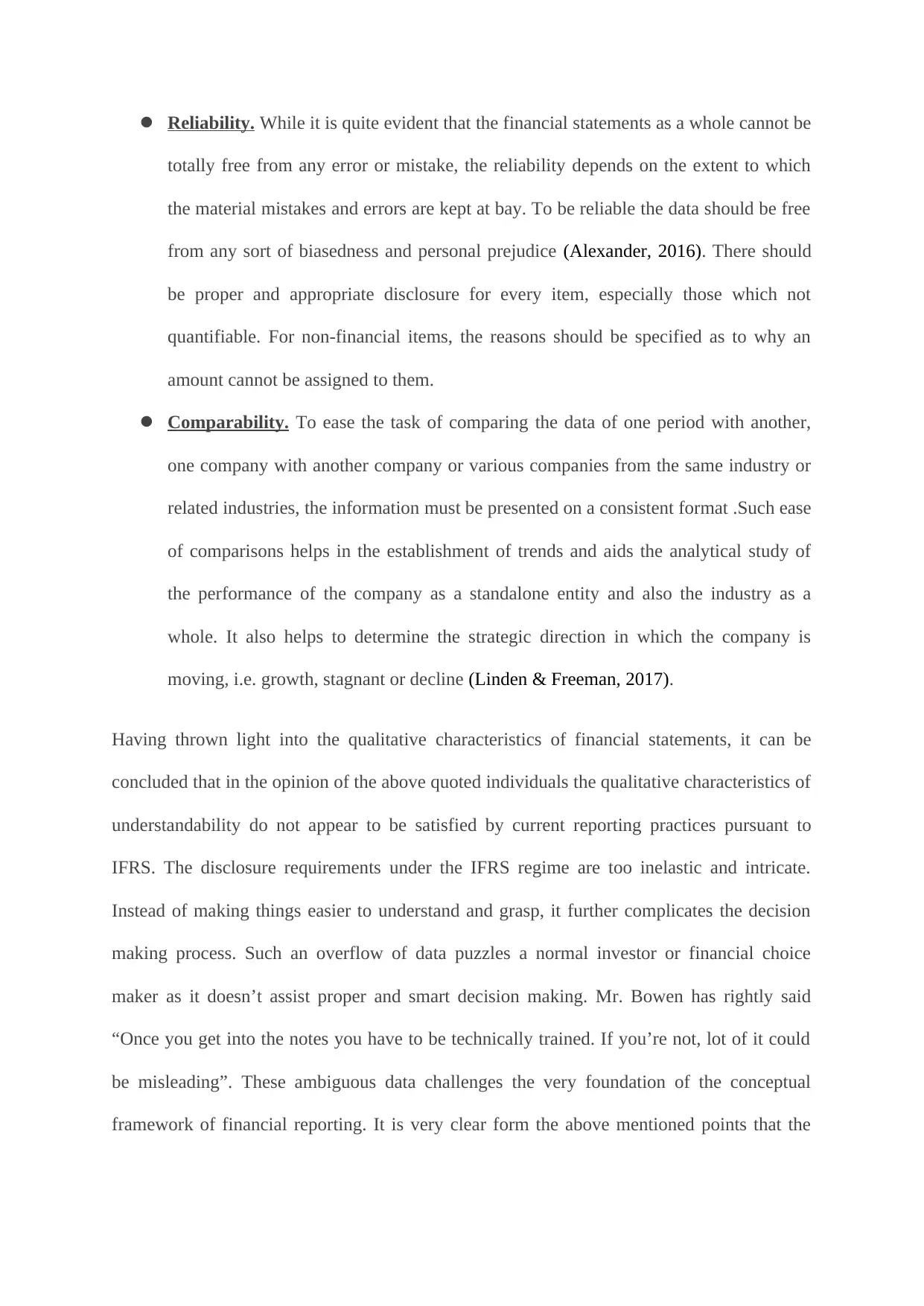
Reliability. While it is quite evident that the financial statements as a whole cannot be
totally free from any error or mistake, the reliability depends on the extent to which
the material mistakes and errors are kept at bay. To be reliable the data should be free
from any sort of biasedness and personal prejudice (Alexander, 2016). There should
be proper and appropriate disclosure for every item, especially those which not
quantifiable. For non-financial items, the reasons should be specified as to why an
amount cannot be assigned to them.
Comparability. To ease the task of comparing the data of one period with another,
one company with another company or various companies from the same industry or
related industries, the information must be presented on a consistent format .Such ease
of comparisons helps in the establishment of trends and aids the analytical study of
the performance of the company as a standalone entity and also the industry as a
whole. It also helps to determine the strategic direction in which the company is
moving, i.e. growth, stagnant or decline (Linden & Freeman, 2017).
Having thrown light into the qualitative characteristics of financial statements, it can be
concluded that in the opinion of the above quoted individuals the qualitative characteristics of
understandability do not appear to be satisfied by current reporting practices pursuant to
IFRS. The disclosure requirements under the IFRS regime are too inelastic and intricate.
Instead of making things easier to understand and grasp, it further complicates the decision
making process. Such an overflow of data puzzles a normal investor or financial choice
maker as it doesn’t assist proper and smart decision making. Mr. Bowen has rightly said
“Once you get into the notes you have to be technically trained. If you’re not, lot of it could
be misleading”. These ambiguous data challenges the very foundation of the conceptual
framework of financial reporting. It is very clear form the above mentioned points that the
totally free from any error or mistake, the reliability depends on the extent to which
the material mistakes and errors are kept at bay. To be reliable the data should be free
from any sort of biasedness and personal prejudice (Alexander, 2016). There should
be proper and appropriate disclosure for every item, especially those which not
quantifiable. For non-financial items, the reasons should be specified as to why an
amount cannot be assigned to them.
Comparability. To ease the task of comparing the data of one period with another,
one company with another company or various companies from the same industry or
related industries, the information must be presented on a consistent format .Such ease
of comparisons helps in the establishment of trends and aids the analytical study of
the performance of the company as a standalone entity and also the industry as a
whole. It also helps to determine the strategic direction in which the company is
moving, i.e. growth, stagnant or decline (Linden & Freeman, 2017).
Having thrown light into the qualitative characteristics of financial statements, it can be
concluded that in the opinion of the above quoted individuals the qualitative characteristics of
understandability do not appear to be satisfied by current reporting practices pursuant to
IFRS. The disclosure requirements under the IFRS regime are too inelastic and intricate.
Instead of making things easier to understand and grasp, it further complicates the decision
making process. Such an overflow of data puzzles a normal investor or financial choice
maker as it doesn’t assist proper and smart decision making. Mr. Bowen has rightly said
“Once you get into the notes you have to be technically trained. If you’re not, lot of it could
be misleading”. These ambiguous data challenges the very foundation of the conceptual
framework of financial reporting. It is very clear form the above mentioned points that the
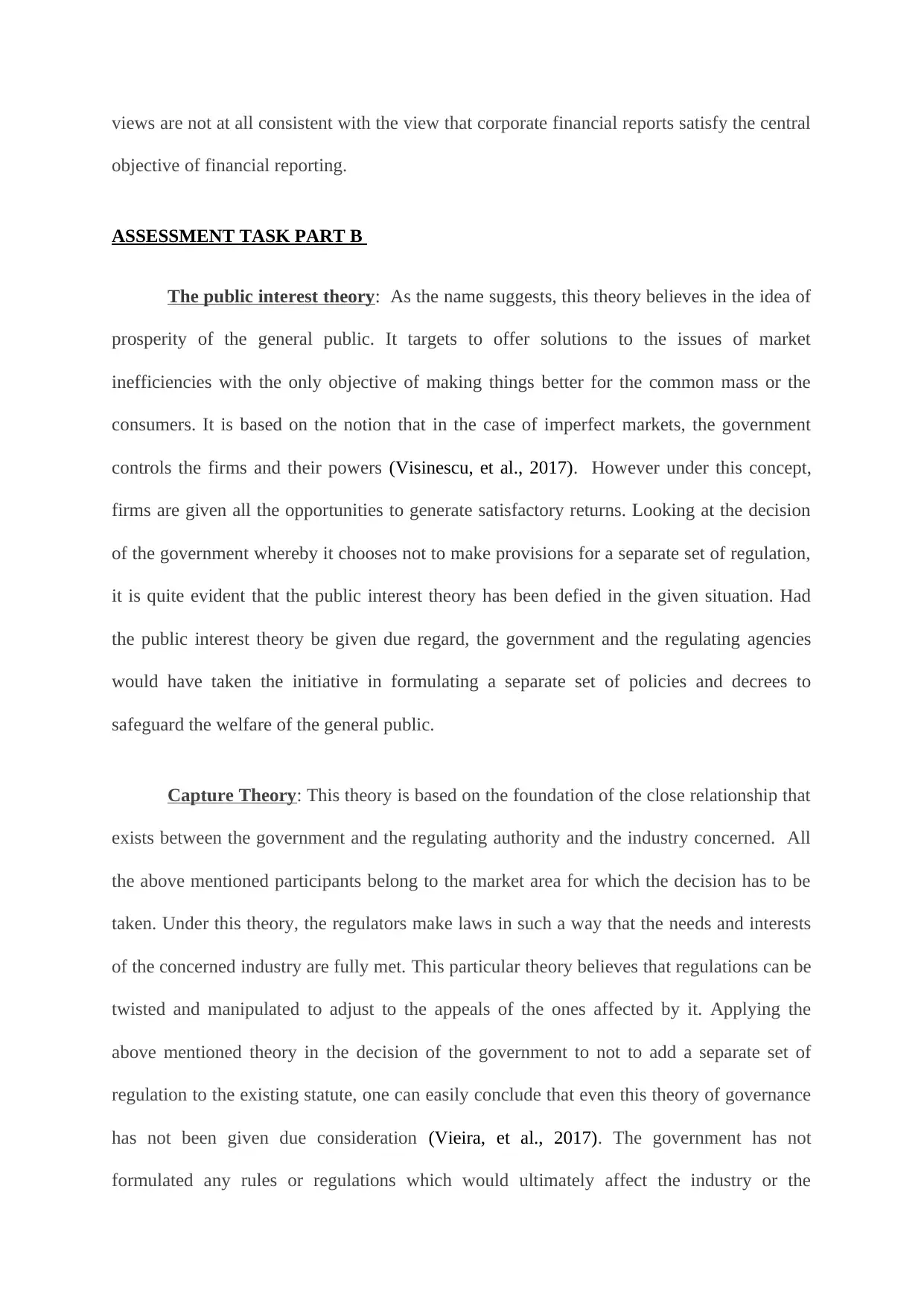
views are not at all consistent with the view that corporate financial reports satisfy the central
objective of financial reporting.
ASSESSMENT TASK PART B
The public interest theory: As the name suggests, this theory believes in the idea of
prosperity of the general public. It targets to offer solutions to the issues of market
inefficiencies with the only objective of making things better for the common mass or the
consumers. It is based on the notion that in the case of imperfect markets, the government
controls the firms and their powers (Visinescu, et al., 2017). However under this concept,
firms are given all the opportunities to generate satisfactory returns. Looking at the decision
of the government whereby it chooses not to make provisions for a separate set of regulation,
it is quite evident that the public interest theory has been defied in the given situation. Had
the public interest theory be given due regard, the government and the regulating agencies
would have taken the initiative in formulating a separate set of policies and decrees to
safeguard the welfare of the general public.
Capture Theory: This theory is based on the foundation of the close relationship that
exists between the government and the regulating authority and the industry concerned. All
the above mentioned participants belong to the market area for which the decision has to be
taken. Under this theory, the regulators make laws in such a way that the needs and interests
of the concerned industry are fully met. This particular theory believes that regulations can be
twisted and manipulated to adjust to the appeals of the ones affected by it. Applying the
above mentioned theory in the decision of the government to not to add a separate set of
regulation to the existing statute, one can easily conclude that even this theory of governance
has not been given due consideration (Vieira, et al., 2017). The government has not
formulated any rules or regulations which would ultimately affect the industry or the
objective of financial reporting.
ASSESSMENT TASK PART B
The public interest theory: As the name suggests, this theory believes in the idea of
prosperity of the general public. It targets to offer solutions to the issues of market
inefficiencies with the only objective of making things better for the common mass or the
consumers. It is based on the notion that in the case of imperfect markets, the government
controls the firms and their powers (Visinescu, et al., 2017). However under this concept,
firms are given all the opportunities to generate satisfactory returns. Looking at the decision
of the government whereby it chooses not to make provisions for a separate set of regulation,
it is quite evident that the public interest theory has been defied in the given situation. Had
the public interest theory be given due regard, the government and the regulating agencies
would have taken the initiative in formulating a separate set of policies and decrees to
safeguard the welfare of the general public.
Capture Theory: This theory is based on the foundation of the close relationship that
exists between the government and the regulating authority and the industry concerned. All
the above mentioned participants belong to the market area for which the decision has to be
taken. Under this theory, the regulators make laws in such a way that the needs and interests
of the concerned industry are fully met. This particular theory believes that regulations can be
twisted and manipulated to adjust to the appeals of the ones affected by it. Applying the
above mentioned theory in the decision of the government to not to add a separate set of
regulation to the existing statute, one can easily conclude that even this theory of governance
has not been given due consideration (Vieira, et al., 2017). The government has not
formulated any rules or regulations which would ultimately affect the industry or the
⊘ This is a preview!⊘
Do you want full access?
Subscribe today to unlock all pages.

Trusted by 1+ million students worldwide
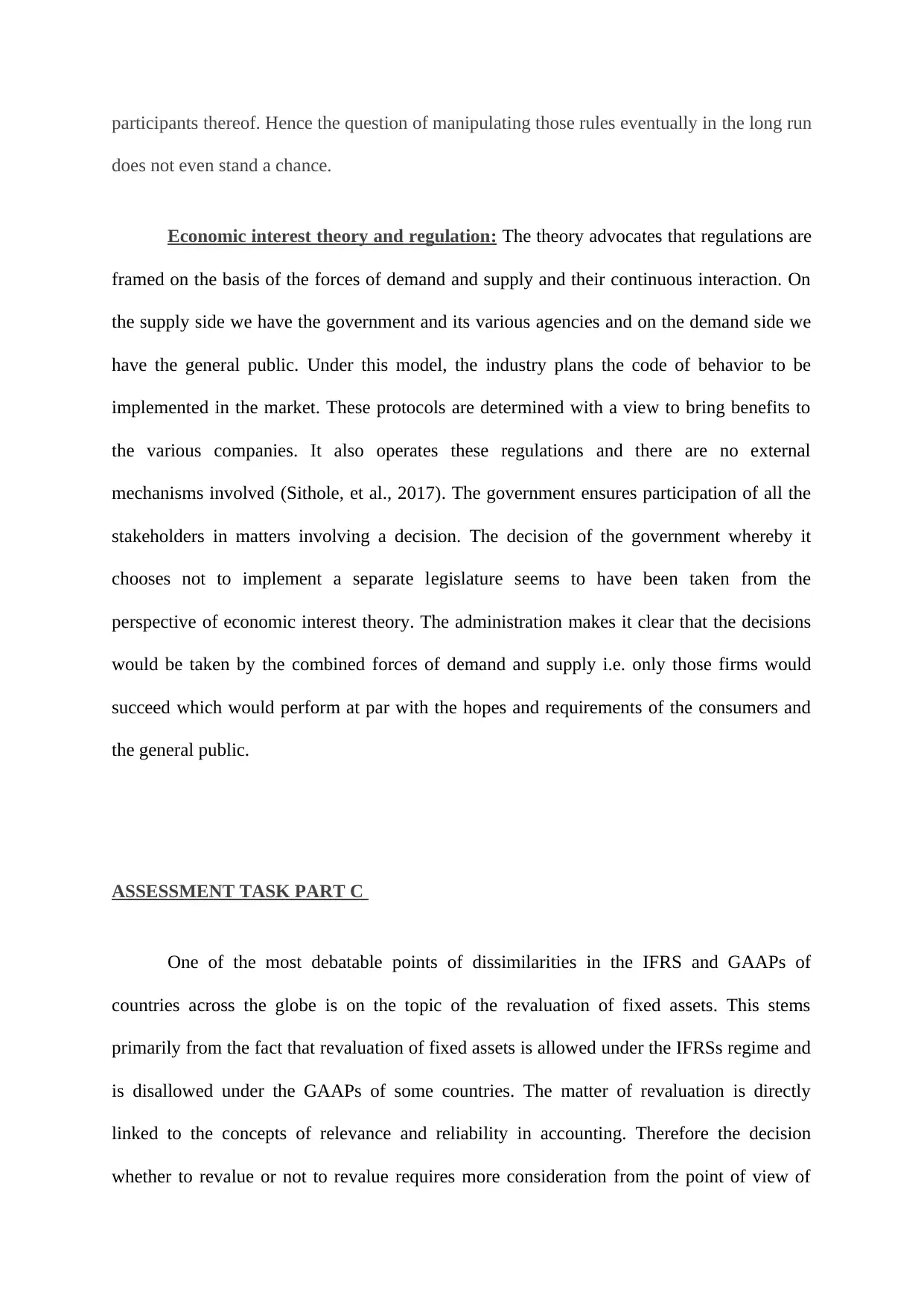
participants thereof. Hence the question of manipulating those rules eventually in the long run
does not even stand a chance.
Economic interest theory and regulation: The theory advocates that regulations are
framed on the basis of the forces of demand and supply and their continuous interaction. On
the supply side we have the government and its various agencies and on the demand side we
have the general public. Under this model, the industry plans the code of behavior to be
implemented in the market. These protocols are determined with a view to bring benefits to
the various companies. It also operates these regulations and there are no external
mechanisms involved (Sithole, et al., 2017). The government ensures participation of all the
stakeholders in matters involving a decision. The decision of the government whereby it
chooses not to implement a separate legislature seems to have been taken from the
perspective of economic interest theory. The administration makes it clear that the decisions
would be taken by the combined forces of demand and supply i.e. only those firms would
succeed which would perform at par with the hopes and requirements of the consumers and
the general public.
ASSESSMENT TASK PART C
One of the most debatable points of dissimilarities in the IFRS and GAAPs of
countries across the globe is on the topic of the revaluation of fixed assets. This stems
primarily from the fact that revaluation of fixed assets is allowed under the IFRSs regime and
is disallowed under the GAAPs of some countries. The matter of revaluation is directly
linked to the concepts of relevance and reliability in accounting. Therefore the decision
whether to revalue or not to revalue requires more consideration from the point of view of
does not even stand a chance.
Economic interest theory and regulation: The theory advocates that regulations are
framed on the basis of the forces of demand and supply and their continuous interaction. On
the supply side we have the government and its various agencies and on the demand side we
have the general public. Under this model, the industry plans the code of behavior to be
implemented in the market. These protocols are determined with a view to bring benefits to
the various companies. It also operates these regulations and there are no external
mechanisms involved (Sithole, et al., 2017). The government ensures participation of all the
stakeholders in matters involving a decision. The decision of the government whereby it
chooses not to implement a separate legislature seems to have been taken from the
perspective of economic interest theory. The administration makes it clear that the decisions
would be taken by the combined forces of demand and supply i.e. only those firms would
succeed which would perform at par with the hopes and requirements of the consumers and
the general public.
ASSESSMENT TASK PART C
One of the most debatable points of dissimilarities in the IFRS and GAAPs of
countries across the globe is on the topic of the revaluation of fixed assets. This stems
primarily from the fact that revaluation of fixed assets is allowed under the IFRSs regime and
is disallowed under the GAAPs of some countries. The matter of revaluation is directly
linked to the concepts of relevance and reliability in accounting. Therefore the decision
whether to revalue or not to revalue requires more consideration from the point of view of
Paraphrase This Document
Need a fresh take? Get an instant paraphrase of this document with our AI Paraphraser
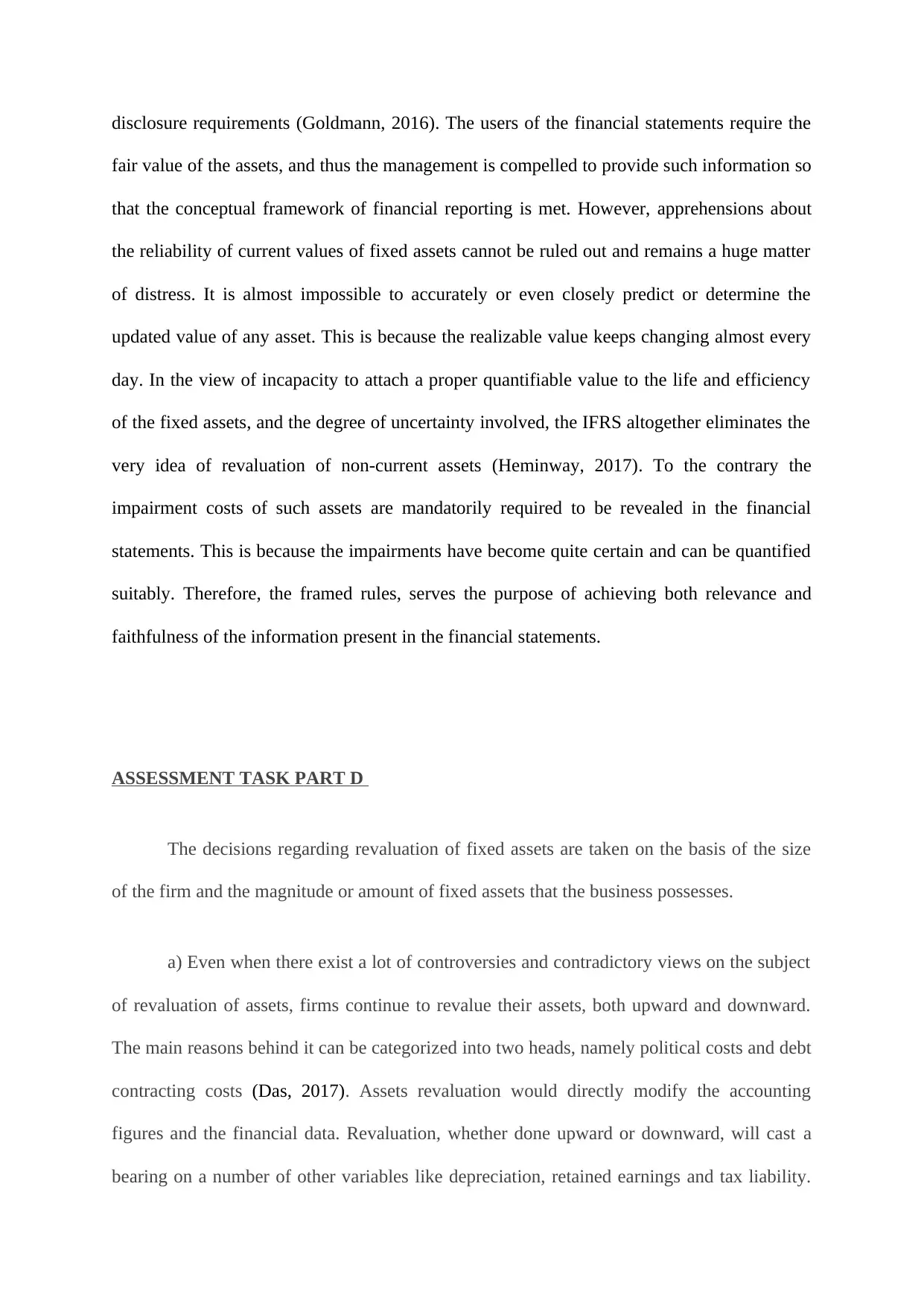
disclosure requirements (Goldmann, 2016). The users of the financial statements require the
fair value of the assets, and thus the management is compelled to provide such information so
that the conceptual framework of financial reporting is met. However, apprehensions about
the reliability of current values of fixed assets cannot be ruled out and remains a huge matter
of distress. It is almost impossible to accurately or even closely predict or determine the
updated value of any asset. This is because the realizable value keeps changing almost every
day. In the view of incapacity to attach a proper quantifiable value to the life and efficiency
of the fixed assets, and the degree of uncertainty involved, the IFRS altogether eliminates the
very idea of revaluation of non-current assets (Heminway, 2017). To the contrary the
impairment costs of such assets are mandatorily required to be revealed in the financial
statements. This is because the impairments have become quite certain and can be quantified
suitably. Therefore, the framed rules, serves the purpose of achieving both relevance and
faithfulness of the information present in the financial statements.
ASSESSMENT TASK PART D
The decisions regarding revaluation of fixed assets are taken on the basis of the size
of the firm and the magnitude or amount of fixed assets that the business possesses.
a) Even when there exist a lot of controversies and contradictory views on the subject
of revaluation of assets, firms continue to revalue their assets, both upward and downward.
The main reasons behind it can be categorized into two heads, namely political costs and debt
contracting costs (Das, 2017). Assets revaluation would directly modify the accounting
figures and the financial data. Revaluation, whether done upward or downward, will cast a
bearing on a number of other variables like depreciation, retained earnings and tax liability.
fair value of the assets, and thus the management is compelled to provide such information so
that the conceptual framework of financial reporting is met. However, apprehensions about
the reliability of current values of fixed assets cannot be ruled out and remains a huge matter
of distress. It is almost impossible to accurately or even closely predict or determine the
updated value of any asset. This is because the realizable value keeps changing almost every
day. In the view of incapacity to attach a proper quantifiable value to the life and efficiency
of the fixed assets, and the degree of uncertainty involved, the IFRS altogether eliminates the
very idea of revaluation of non-current assets (Heminway, 2017). To the contrary the
impairment costs of such assets are mandatorily required to be revealed in the financial
statements. This is because the impairments have become quite certain and can be quantified
suitably. Therefore, the framed rules, serves the purpose of achieving both relevance and
faithfulness of the information present in the financial statements.
ASSESSMENT TASK PART D
The decisions regarding revaluation of fixed assets are taken on the basis of the size
of the firm and the magnitude or amount of fixed assets that the business possesses.
a) Even when there exist a lot of controversies and contradictory views on the subject
of revaluation of assets, firms continue to revalue their assets, both upward and downward.
The main reasons behind it can be categorized into two heads, namely political costs and debt
contracting costs (Das, 2017). Assets revaluation would directly modify the accounting
figures and the financial data. Revaluation, whether done upward or downward, will cast a
bearing on a number of other variables like depreciation, retained earnings and tax liability.
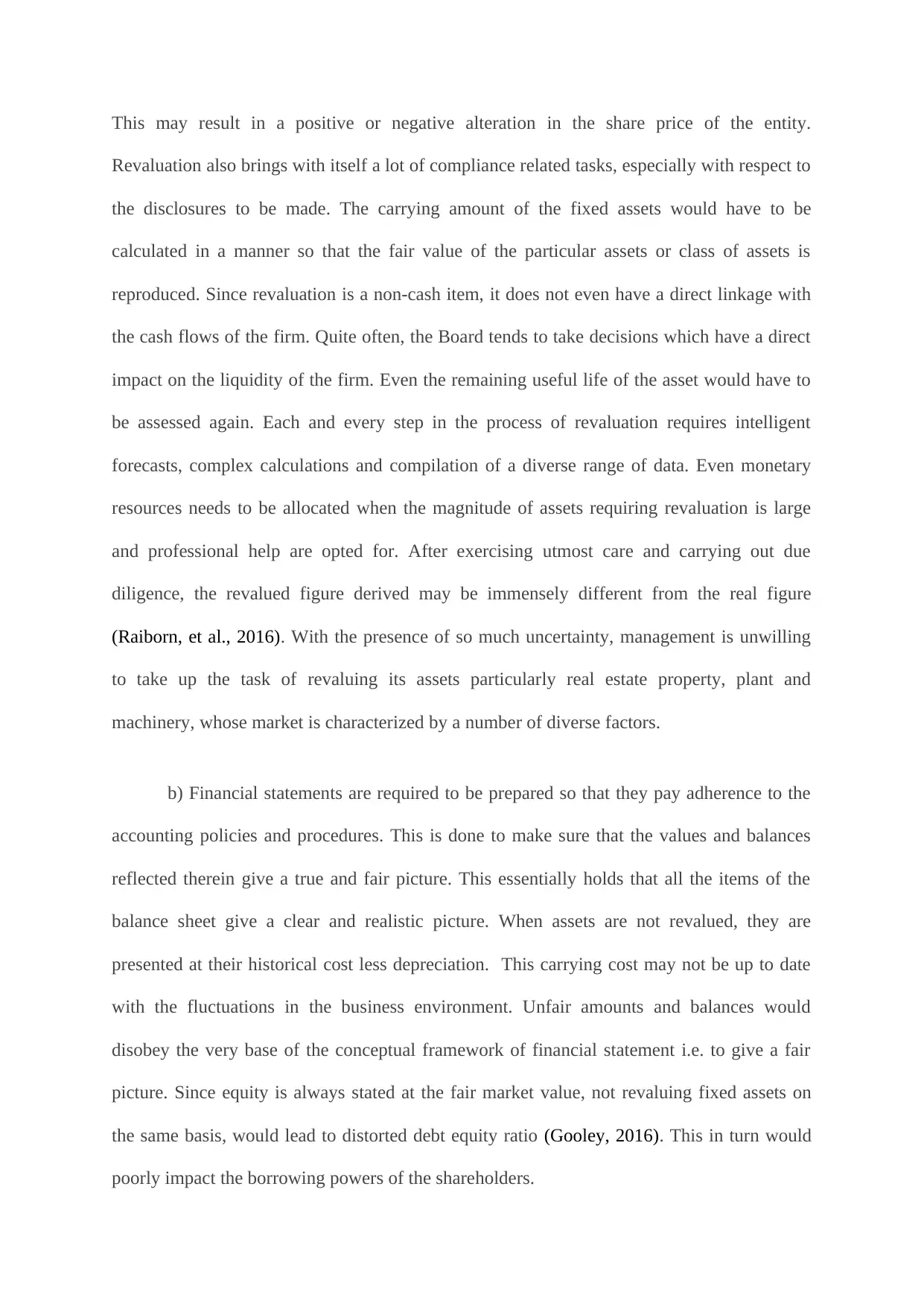
This may result in a positive or negative alteration in the share price of the entity.
Revaluation also brings with itself a lot of compliance related tasks, especially with respect to
the disclosures to be made. The carrying amount of the fixed assets would have to be
calculated in a manner so that the fair value of the particular assets or class of assets is
reproduced. Since revaluation is a non-cash item, it does not even have a direct linkage with
the cash flows of the firm. Quite often, the Board tends to take decisions which have a direct
impact on the liquidity of the firm. Even the remaining useful life of the asset would have to
be assessed again. Each and every step in the process of revaluation requires intelligent
forecasts, complex calculations and compilation of a diverse range of data. Even monetary
resources needs to be allocated when the magnitude of assets requiring revaluation is large
and professional help are opted for. After exercising utmost care and carrying out due
diligence, the revalued figure derived may be immensely different from the real figure
(Raiborn, et al., 2016). With the presence of so much uncertainty, management is unwilling
to take up the task of revaluing its assets particularly real estate property, plant and
machinery, whose market is characterized by a number of diverse factors.
b) Financial statements are required to be prepared so that they pay adherence to the
accounting policies and procedures. This is done to make sure that the values and balances
reflected therein give a true and fair picture. This essentially holds that all the items of the
balance sheet give a clear and realistic picture. When assets are not revalued, they are
presented at their historical cost less depreciation. This carrying cost may not be up to date
with the fluctuations in the business environment. Unfair amounts and balances would
disobey the very base of the conceptual framework of financial statement i.e. to give a fair
picture. Since equity is always stated at the fair market value, not revaluing fixed assets on
the same basis, would lead to distorted debt equity ratio (Gooley, 2016). This in turn would
poorly impact the borrowing powers of the shareholders.
Revaluation also brings with itself a lot of compliance related tasks, especially with respect to
the disclosures to be made. The carrying amount of the fixed assets would have to be
calculated in a manner so that the fair value of the particular assets or class of assets is
reproduced. Since revaluation is a non-cash item, it does not even have a direct linkage with
the cash flows of the firm. Quite often, the Board tends to take decisions which have a direct
impact on the liquidity of the firm. Even the remaining useful life of the asset would have to
be assessed again. Each and every step in the process of revaluation requires intelligent
forecasts, complex calculations and compilation of a diverse range of data. Even monetary
resources needs to be allocated when the magnitude of assets requiring revaluation is large
and professional help are opted for. After exercising utmost care and carrying out due
diligence, the revalued figure derived may be immensely different from the real figure
(Raiborn, et al., 2016). With the presence of so much uncertainty, management is unwilling
to take up the task of revaluing its assets particularly real estate property, plant and
machinery, whose market is characterized by a number of diverse factors.
b) Financial statements are required to be prepared so that they pay adherence to the
accounting policies and procedures. This is done to make sure that the values and balances
reflected therein give a true and fair picture. This essentially holds that all the items of the
balance sheet give a clear and realistic picture. When assets are not revalued, they are
presented at their historical cost less depreciation. This carrying cost may not be up to date
with the fluctuations in the business environment. Unfair amounts and balances would
disobey the very base of the conceptual framework of financial statement i.e. to give a fair
picture. Since equity is always stated at the fair market value, not revaluing fixed assets on
the same basis, would lead to distorted debt equity ratio (Gooley, 2016). This in turn would
poorly impact the borrowing powers of the shareholders.
⊘ This is a preview!⊘
Do you want full access?
Subscribe today to unlock all pages.

Trusted by 1+ million students worldwide
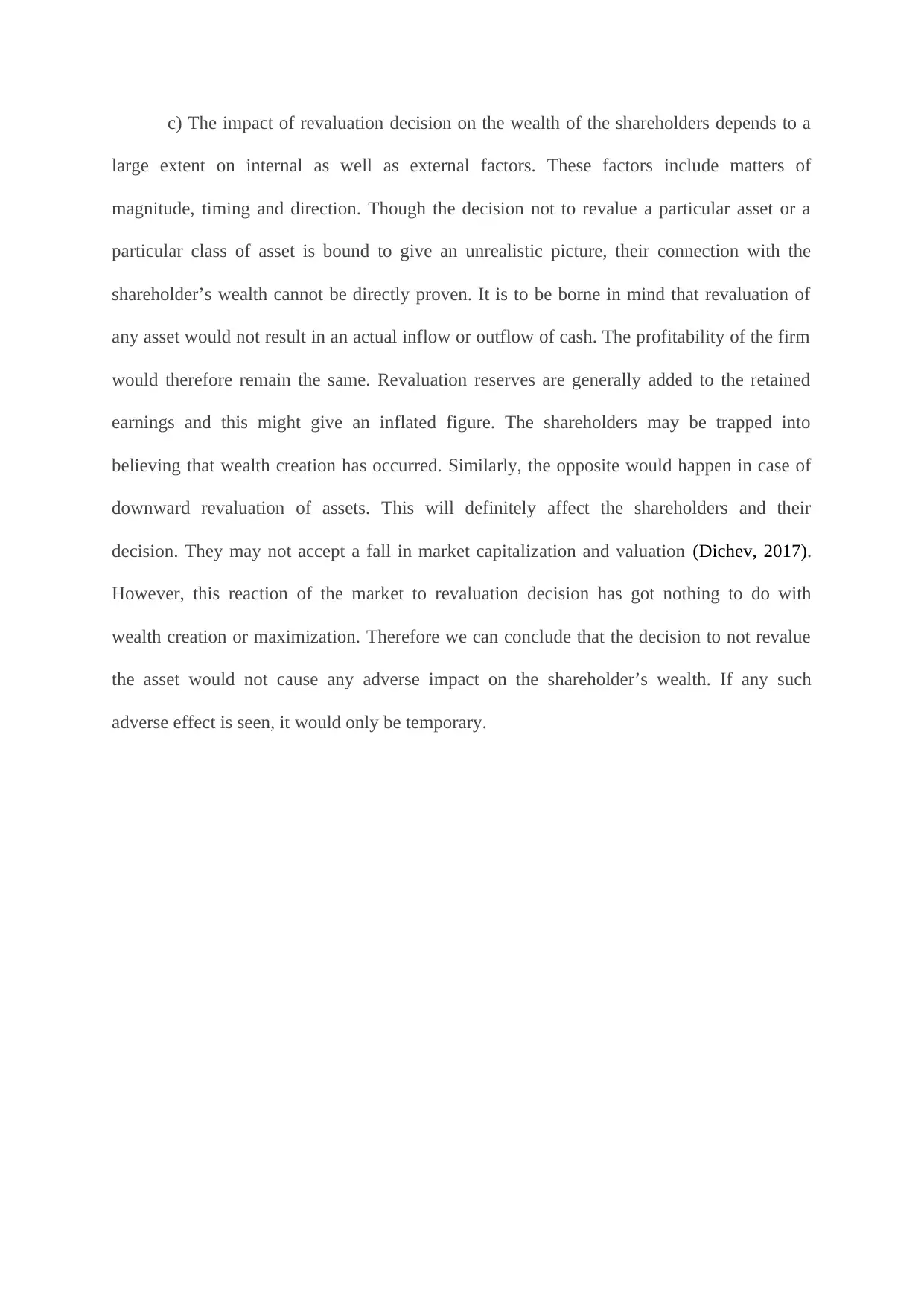
c) The impact of revaluation decision on the wealth of the shareholders depends to a
large extent on internal as well as external factors. These factors include matters of
magnitude, timing and direction. Though the decision not to revalue a particular asset or a
particular class of asset is bound to give an unrealistic picture, their connection with the
shareholder’s wealth cannot be directly proven. It is to be borne in mind that revaluation of
any asset would not result in an actual inflow or outflow of cash. The profitability of the firm
would therefore remain the same. Revaluation reserves are generally added to the retained
earnings and this might give an inflated figure. The shareholders may be trapped into
believing that wealth creation has occurred. Similarly, the opposite would happen in case of
downward revaluation of assets. This will definitely affect the shareholders and their
decision. They may not accept a fall in market capitalization and valuation (Dichev, 2017).
However, this reaction of the market to revaluation decision has got nothing to do with
wealth creation or maximization. Therefore we can conclude that the decision to not revalue
the asset would not cause any adverse impact on the shareholder’s wealth. If any such
adverse effect is seen, it would only be temporary.
large extent on internal as well as external factors. These factors include matters of
magnitude, timing and direction. Though the decision not to revalue a particular asset or a
particular class of asset is bound to give an unrealistic picture, their connection with the
shareholder’s wealth cannot be directly proven. It is to be borne in mind that revaluation of
any asset would not result in an actual inflow or outflow of cash. The profitability of the firm
would therefore remain the same. Revaluation reserves are generally added to the retained
earnings and this might give an inflated figure. The shareholders may be trapped into
believing that wealth creation has occurred. Similarly, the opposite would happen in case of
downward revaluation of assets. This will definitely affect the shareholders and their
decision. They may not accept a fall in market capitalization and valuation (Dichev, 2017).
However, this reaction of the market to revaluation decision has got nothing to do with
wealth creation or maximization. Therefore we can conclude that the decision to not revalue
the asset would not cause any adverse impact on the shareholder’s wealth. If any such
adverse effect is seen, it would only be temporary.
Paraphrase This Document
Need a fresh take? Get an instant paraphrase of this document with our AI Paraphraser
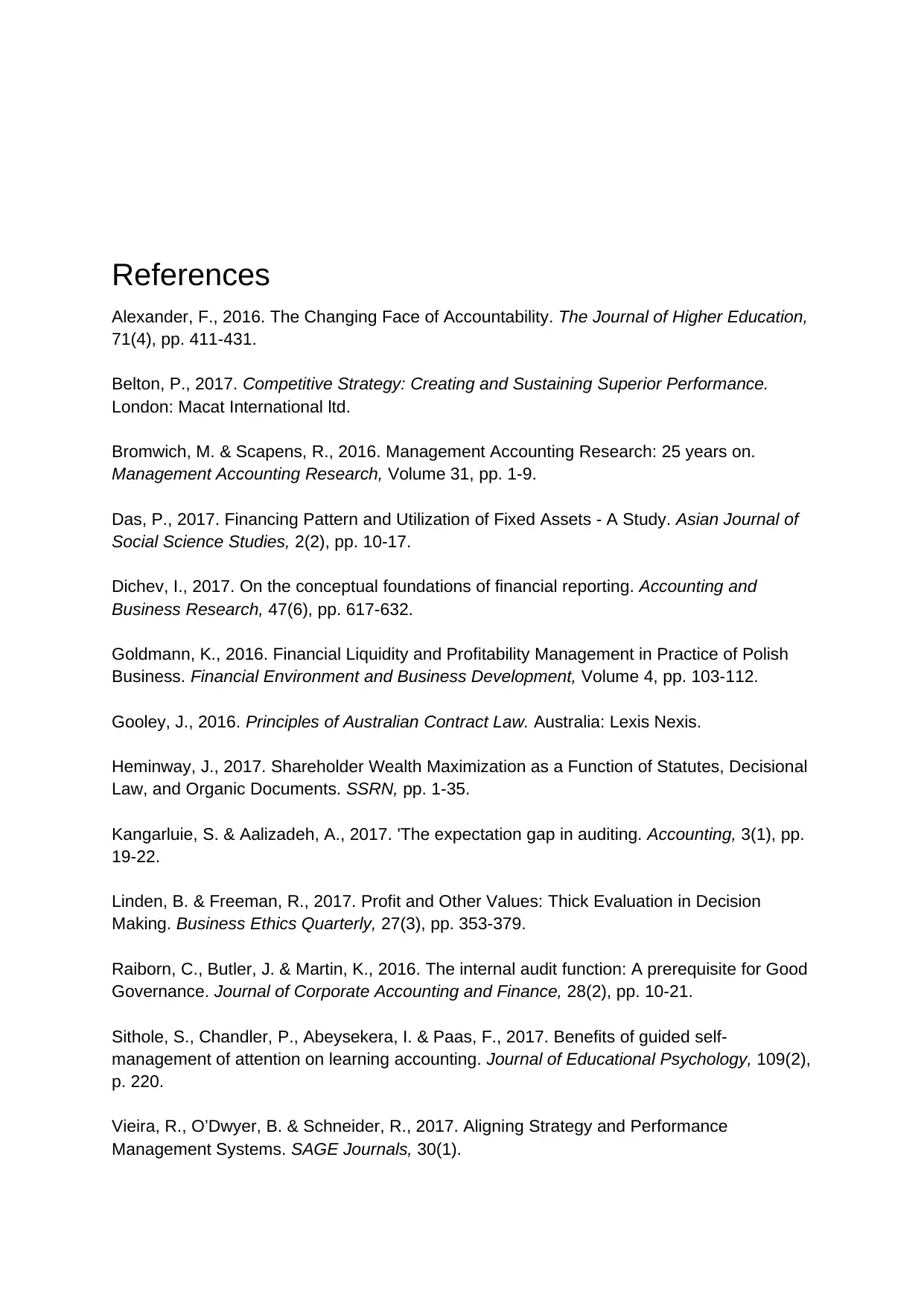
References
Alexander, F., 2016. The Changing Face of Accountability. The Journal of Higher Education,
71(4), pp. 411-431.
Belton, P., 2017. Competitive Strategy: Creating and Sustaining Superior Performance.
London: Macat International ltd.
Bromwich, M. & Scapens, R., 2016. Management Accounting Research: 25 years on.
Management Accounting Research, Volume 31, pp. 1-9.
Das, P., 2017. Financing Pattern and Utilization of Fixed Assets - A Study. Asian Journal of
Social Science Studies, 2(2), pp. 10-17.
Dichev, I., 2017. On the conceptual foundations of financial reporting. Accounting and
Business Research, 47(6), pp. 617-632.
Goldmann, K., 2016. Financial Liquidity and Profitability Management in Practice of Polish
Business. Financial Environment and Business Development, Volume 4, pp. 103-112.
Gooley, J., 2016. Principles of Australian Contract Law. Australia: Lexis Nexis.
Heminway, J., 2017. Shareholder Wealth Maximization as a Function of Statutes, Decisional
Law, and Organic Documents. SSRN, pp. 1-35.
Kangarluie, S. & Aalizadeh, A., 2017. 'The expectation gap in auditing. Accounting, 3(1), pp.
19-22.
Linden, B. & Freeman, R., 2017. Profit and Other Values: Thick Evaluation in Decision
Making. Business Ethics Quarterly, 27(3), pp. 353-379.
Raiborn, C., Butler, J. & Martin, K., 2016. The internal audit function: A prerequisite for Good
Governance. Journal of Corporate Accounting and Finance, 28(2), pp. 10-21.
Sithole, S., Chandler, P., Abeysekera, I. & Paas, F., 2017. Benefits of guided self-
management of attention on learning accounting. Journal of Educational Psychology, 109(2),
p. 220.
Vieira, R., O’Dwyer, B. & Schneider, R., 2017. Aligning Strategy and Performance
Management Systems. SAGE Journals, 30(1).
Alexander, F., 2016. The Changing Face of Accountability. The Journal of Higher Education,
71(4), pp. 411-431.
Belton, P., 2017. Competitive Strategy: Creating and Sustaining Superior Performance.
London: Macat International ltd.
Bromwich, M. & Scapens, R., 2016. Management Accounting Research: 25 years on.
Management Accounting Research, Volume 31, pp. 1-9.
Das, P., 2017. Financing Pattern and Utilization of Fixed Assets - A Study. Asian Journal of
Social Science Studies, 2(2), pp. 10-17.
Dichev, I., 2017. On the conceptual foundations of financial reporting. Accounting and
Business Research, 47(6), pp. 617-632.
Goldmann, K., 2016. Financial Liquidity and Profitability Management in Practice of Polish
Business. Financial Environment and Business Development, Volume 4, pp. 103-112.
Gooley, J., 2016. Principles of Australian Contract Law. Australia: Lexis Nexis.
Heminway, J., 2017. Shareholder Wealth Maximization as a Function of Statutes, Decisional
Law, and Organic Documents. SSRN, pp. 1-35.
Kangarluie, S. & Aalizadeh, A., 2017. 'The expectation gap in auditing. Accounting, 3(1), pp.
19-22.
Linden, B. & Freeman, R., 2017. Profit and Other Values: Thick Evaluation in Decision
Making. Business Ethics Quarterly, 27(3), pp. 353-379.
Raiborn, C., Butler, J. & Martin, K., 2016. The internal audit function: A prerequisite for Good
Governance. Journal of Corporate Accounting and Finance, 28(2), pp. 10-21.
Sithole, S., Chandler, P., Abeysekera, I. & Paas, F., 2017. Benefits of guided self-
management of attention on learning accounting. Journal of Educational Psychology, 109(2),
p. 220.
Vieira, R., O’Dwyer, B. & Schneider, R., 2017. Aligning Strategy and Performance
Management Systems. SAGE Journals, 30(1).
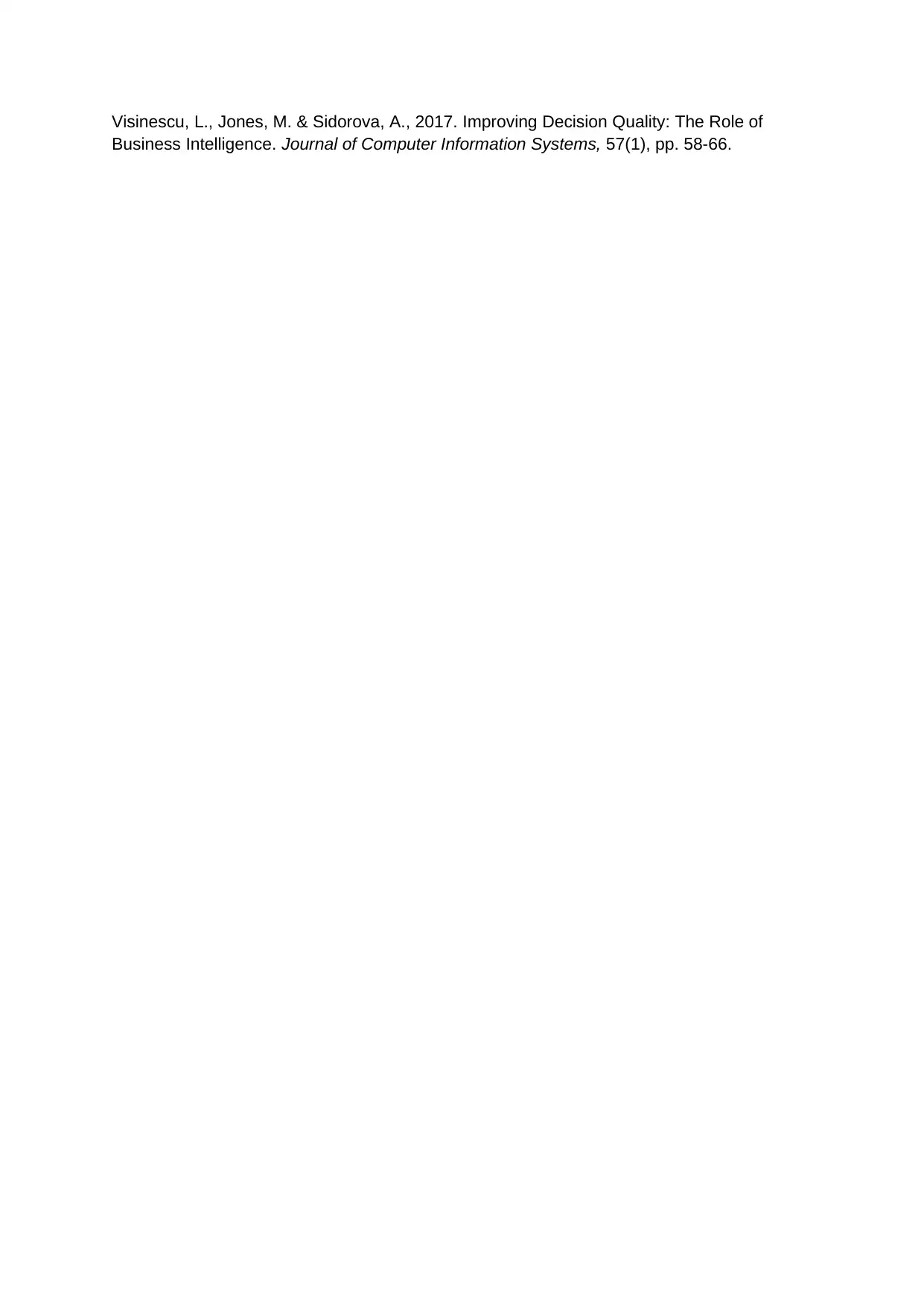
Visinescu, L., Jones, M. & Sidorova, A., 2017. Improving Decision Quality: The Role of
Business Intelligence. Journal of Computer Information Systems, 57(1), pp. 58-66.
Business Intelligence. Journal of Computer Information Systems, 57(1), pp. 58-66.
⊘ This is a preview!⊘
Do you want full access?
Subscribe today to unlock all pages.

Trusted by 1+ million students worldwide
1 out of 9
Related Documents
Your All-in-One AI-Powered Toolkit for Academic Success.
+13062052269
info@desklib.com
Available 24*7 on WhatsApp / Email
![[object Object]](/_next/static/media/star-bottom.7253800d.svg)
Unlock your academic potential
Copyright © 2020–2025 A2Z Services. All Rights Reserved. Developed and managed by ZUCOL.





